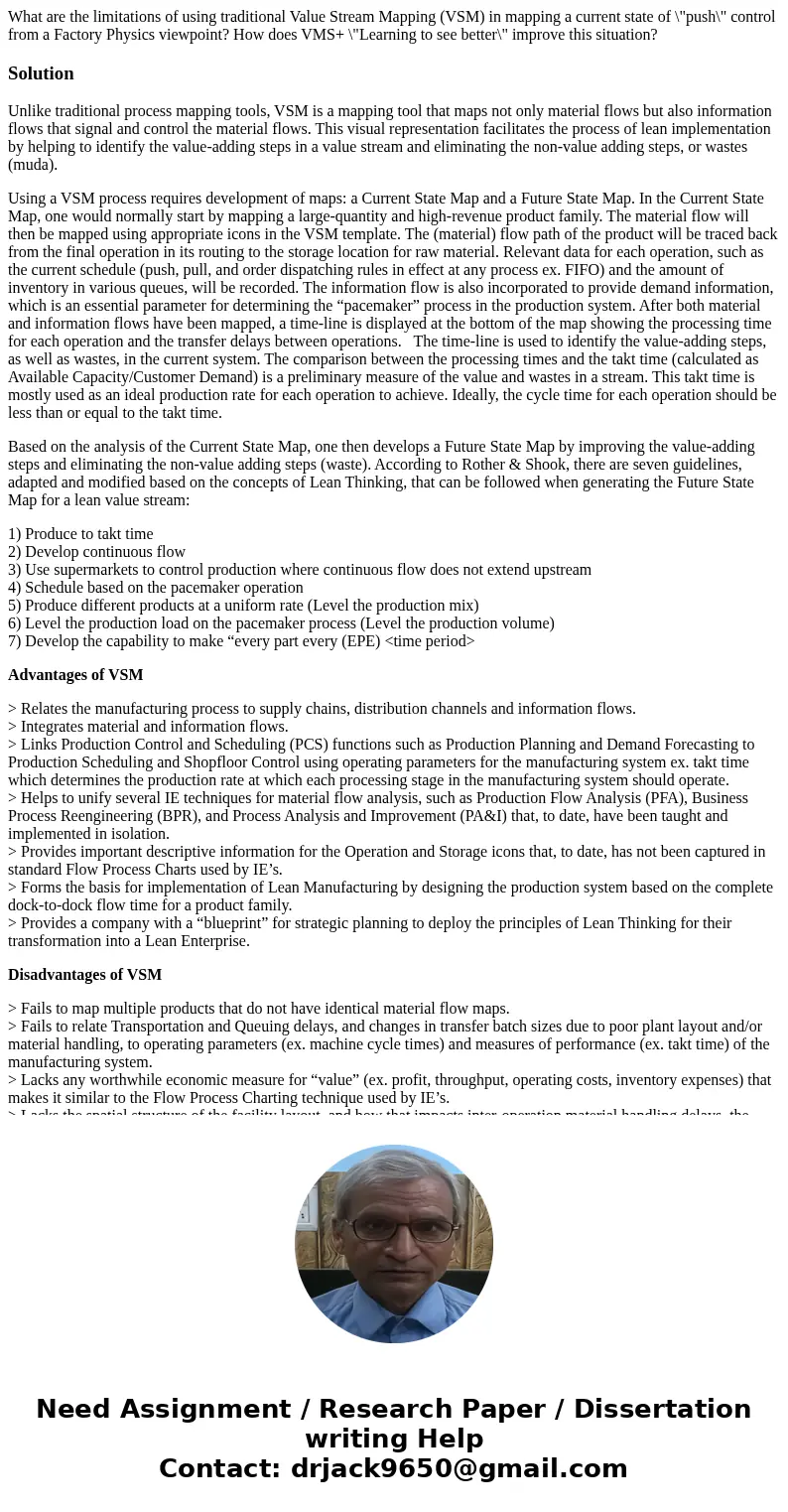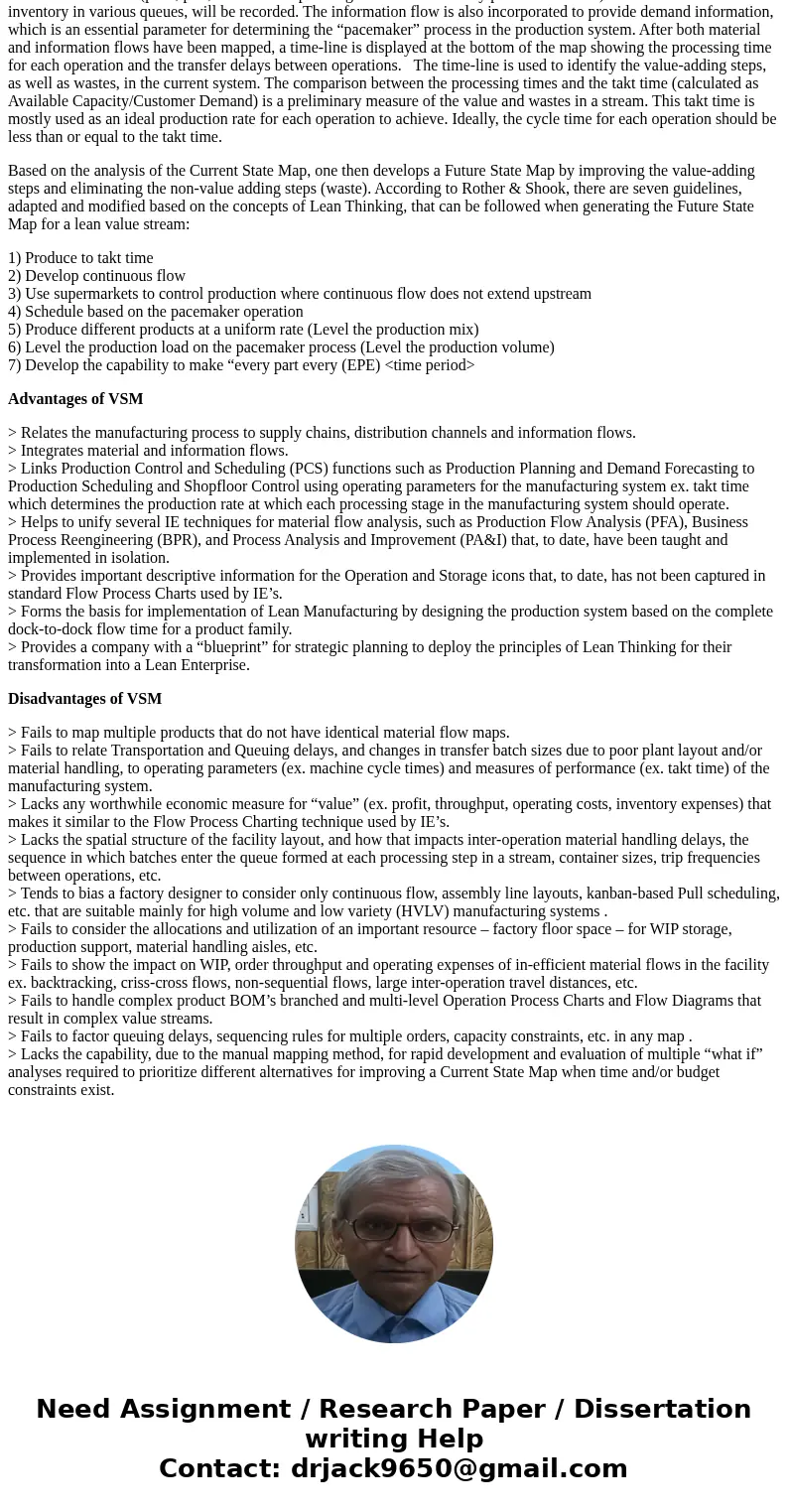What are the limitations of using traditional Value Stream M
Solution
Unlike traditional process mapping tools, VSM is a mapping tool that maps not only material flows but also information flows that signal and control the material flows. This visual representation facilitates the process of lean implementation by helping to identify the value-adding steps in a value stream and eliminating the non-value adding steps, or wastes (muda).
Using a VSM process requires development of maps: a Current State Map and a Future State Map. In the Current State Map, one would normally start by mapping a large-quantity and high-revenue product family. The material flow will then be mapped using appropriate icons in the VSM template. The (material) flow path of the product will be traced back from the final operation in its routing to the storage location for raw material. Relevant data for each operation, such as the current schedule (push, pull, and order dispatching rules in effect at any process ex. FIFO) and the amount of inventory in various queues, will be recorded. The information flow is also incorporated to provide demand information, which is an essential parameter for determining the “pacemaker” process in the production system. After both material and information flows have been mapped, a time-line is displayed at the bottom of the map showing the processing time for each operation and the transfer delays between operations. The time-line is used to identify the value-adding steps, as well as wastes, in the current system. The comparison between the processing times and the takt time (calculated as Available Capacity/Customer Demand) is a preliminary measure of the value and wastes in a stream. This takt time is mostly used as an ideal production rate for each operation to achieve. Ideally, the cycle time for each operation should be less than or equal to the takt time.
Based on the analysis of the Current State Map, one then develops a Future State Map by improving the value-adding steps and eliminating the non-value adding steps (waste). According to Rother & Shook, there are seven guidelines, adapted and modified based on the concepts of Lean Thinking, that can be followed when generating the Future State Map for a lean value stream:
1) Produce to takt time
2) Develop continuous flow
3) Use supermarkets to control production where continuous flow does not extend upstream
4) Schedule based on the pacemaker operation
5) Produce different products at a uniform rate (Level the production mix)
6) Level the production load on the pacemaker process (Level the production volume)
7) Develop the capability to make “every part every (EPE) <time period>
Advantages of VSM
> Relates the manufacturing process to supply chains, distribution channels and information flows.
> Integrates material and information flows.
> Links Production Control and Scheduling (PCS) functions such as Production Planning and Demand Forecasting to Production Scheduling and Shopfloor Control using operating parameters for the manufacturing system ex. takt time which determines the production rate at which each processing stage in the manufacturing system should operate.
> Helps to unify several IE techniques for material flow analysis, such as Production Flow Analysis (PFA), Business Process Reengineering (BPR), and Process Analysis and Improvement (PA&I) that, to date, have been taught and implemented in isolation.
> Provides important descriptive information for the Operation and Storage icons that, to date, has not been captured in standard Flow Process Charts used by IE’s.
> Forms the basis for implementation of Lean Manufacturing by designing the production system based on the complete dock-to-dock flow time for a product family.
> Provides a company with a “blueprint” for strategic planning to deploy the principles of Lean Thinking for their transformation into a Lean Enterprise.
Disadvantages of VSM
> Fails to map multiple products that do not have identical material flow maps.
> Fails to relate Transportation and Queuing delays, and changes in transfer batch sizes due to poor plant layout and/or material handling, to operating parameters (ex. machine cycle times) and measures of performance (ex. takt time) of the manufacturing system.
> Lacks any worthwhile economic measure for “value” (ex. profit, throughput, operating costs, inventory expenses) that makes it similar to the Flow Process Charting technique used by IE’s.
> Lacks the spatial structure of the facility layout, and how that impacts inter-operation material handling delays, the sequence in which batches enter the queue formed at each processing step in a stream, container sizes, trip frequencies between operations, etc.
> Tends to bias a factory designer to consider only continuous flow, assembly line layouts, kanban-based Pull scheduling, etc. that are suitable mainly for high volume and low variety (HVLV) manufacturing systems .
> Fails to consider the allocations and utilization of an important resource – factory floor space – for WIP storage, production support, material handling aisles, etc.
> Fails to show the impact on WIP, order throughput and operating expenses of in-efficient material flows in the facility ex. backtracking, criss-cross flows, non-sequential flows, large inter-operation travel distances, etc.
> Fails to handle complex product BOM’s branched and multi-level Operation Process Charts and Flow Diagrams that result in complex value streams.
> Fails to factor queuing delays, sequencing rules for multiple orders, capacity constraints, etc. in any map .
> Lacks the capability, due to the manual mapping method, for rapid development and evaluation of multiple “what if” analyses required to prioritize different alternatives for improving a Current State Map when time and/or budget constraints exist.


 Homework Sourse
Homework Sourse